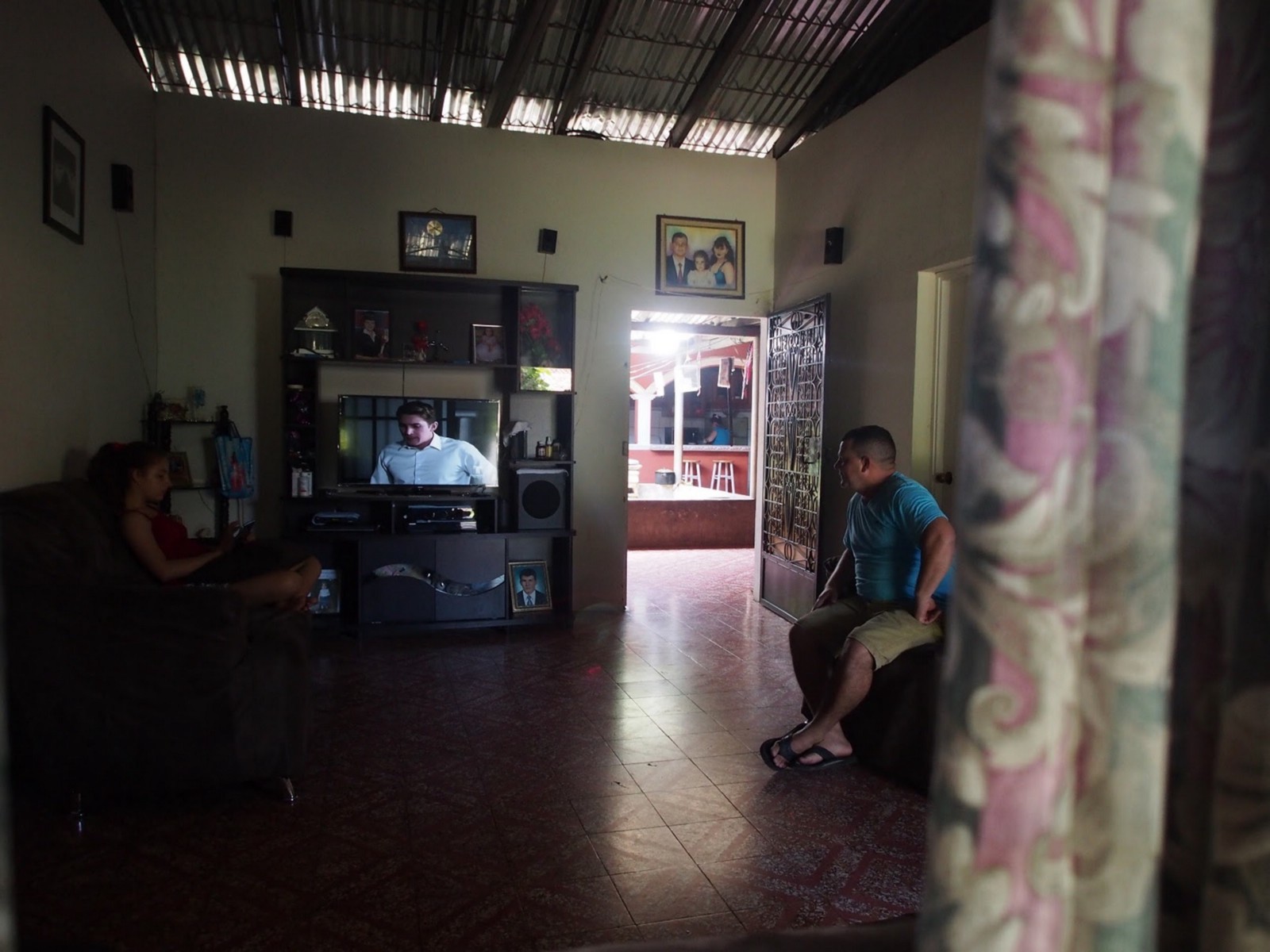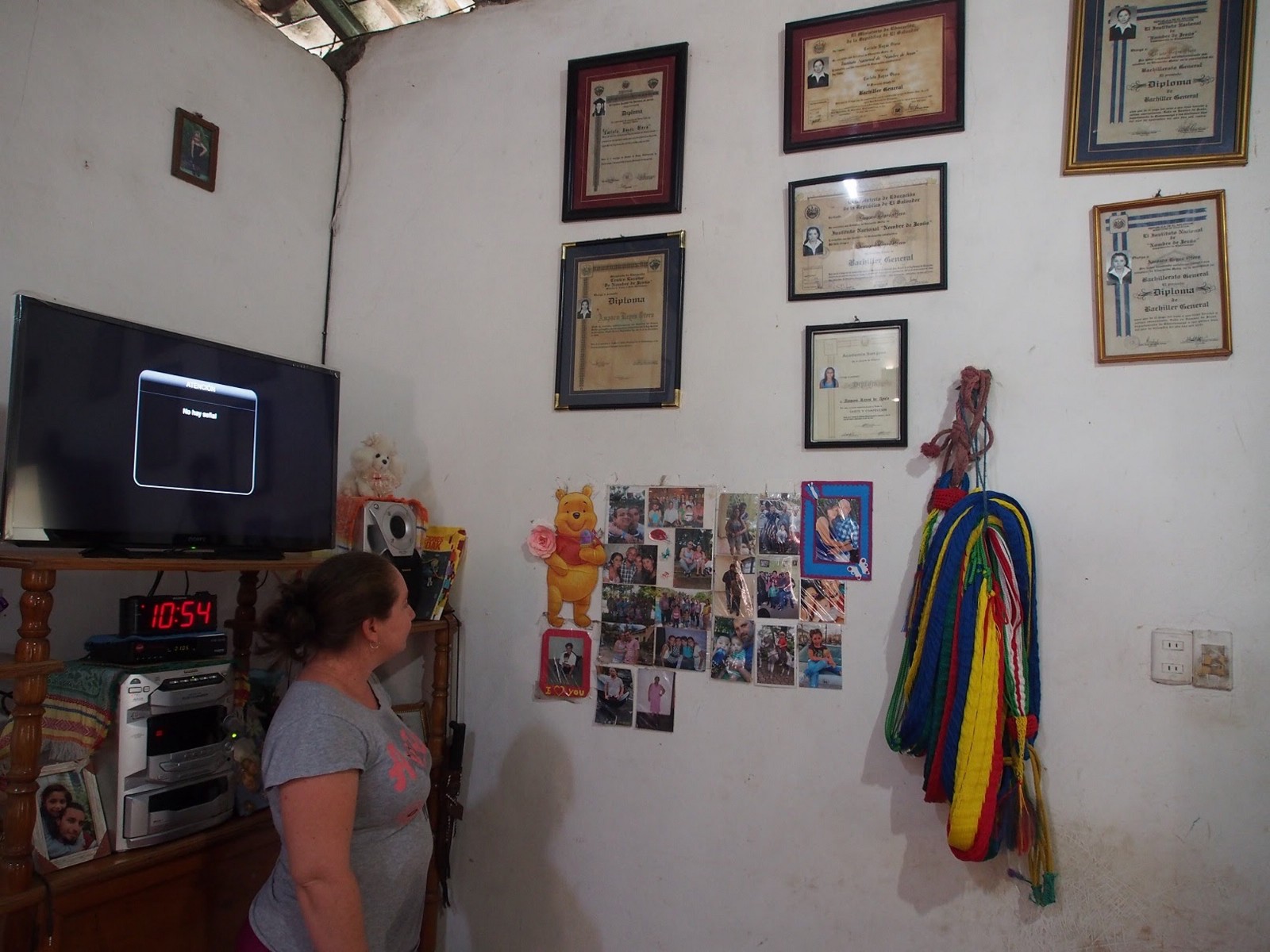Victor Manuel Rodriguez finishes work on his farm and tends to his knife-sharpening. Mid-day, he plonks his feet up on the hammock and drifts into a nap; one his granddaughters colors a book nearby. Most of the rooms in his large home are empty, but the 69-year-old flashes the smile of a content man. It may have been a decade since he last saw four of his 13 children, but he is happy to live an American dream in the village of Hacienda Vieja in the Chalatenango department of El Salvador, where he was born and continues to live.
Rodriguez’s eldest son left for the United States 20 years ago. He never imagined that five of 13 children would follow the track of their eldest brother: at different points in time, without documents, seeking a better life away from the poverty. Only three daughters continue to live in the same village with their family; the other four have migrated to the country’s capital in San Salvador.
Rodriguez is aware that asking them to visit home would mean that they may not be able to return to the U.S. again, where they have established their own families. But what Rodriguez and his wife Maria make peace with, in the absence of their children, is that they have a much larger and comfortable house today — like the people in the U.S. they see on TV.
The story of the Rodriguez family is congruent with that of almost every household in Hacienda Vieja. Up in the hills of El Salvador, adjacent to Honduras, the village is today mostly inhabited by children and older people like Rodriguez. Seemingly every family has had a member living in the U.S. for several years now; every family has at least one family member whom they haven’t seen for years. The village is home to 250 families, but only 430 people live here.
One-third of El Salvador’s 6.34 million people — nearly two million — reside in the U.S. According to a Pew Research Center report of 2013, El Salvador received a total of USD 4.2 billion in remittances. According to the World Bank, the remittances contribute to 16.5 percent of the country’s gross domestic product.
“It is my duty as her father to ensure a better life for her.”
The path to reach the U.S. is a treacherous one: Migrants depend on “coyotes” — smugglers who facilitate the migration of people on the Mexico-U.S. border — and that means a route of uncertainty and danger. Those who have weathered this migration aren’t always able to truly impress the full hardship to their families back home. But, those families continue to reap the economic benefits of any remittances sent home.
“We had a small house, and it was very difficult to accommodate when the children were growing up,” he says, raising his head from the hammock to emphasize the grim situation of the past. “But now we have a big home. Three of my daughters who are married and live in the village bring their children to play with us, and that makes me very happy,” he says, acknowledging that he may not have the chance to see his grandchildren growing up in the U.S.
Their two-story home is guarded by a tall metal gate. On the entrance wall is a large poster of Oscar Romero, the archbishop of El Salvador who spoke out against social injustice and was assassinated in 1980. His death provoked the civil war in El Salvador that lasted 12 years. Four of the Rodriguez children who immigrated in the 1990s have since managed to pay their parents a visit. During one such visit, Rodriguez sent along one of his grandsons whom he was raising with his wife.
The widespread feelings of missing the family left behind can be abated at times by remembering what that sacrifice has afforded the family back home. But things can be just as difficult for those who’ve stayed behind.
Sociologist Leisy Abrego, a professor at the University of California–Los Angeles, feels that there is not one singular sentiment among those who stay behind. In her book Sacrificing Families: Navigating Laws, Labor, and Love Across Borders, she probes the lives of Salvadoran transnational families, how their parents fare in the U.S., and the experiences of the children back home.
“When parents migrate to the U.S., the children are very excited in the beginning, at the prospect of receiving toys. After a few years, when they are in their adolescence and have not seen their parents for three years or more, they become resentful. When they get older and have their own families, they understand better the rationale to leave children behind, and make peace with their parents who had migrated. So where they are in their own family formation process opens the door to understanding the many experiences of migration,” says Abrego, who was a child when she herself migrated with her parents to the U.S. from El Salvador.
For his part, Atilio Ayala hasn’t noticed any resentment from his children. Ayala lives near the Rodriguez household, in a common compound that contains two houses: a smaller dilapidating house where Ayala’s parents continue to live, and a larger one with bright orange walls and a tiled courtyard with a hammock where the 36-year-old lives with his wife and three daughters. He recently returned home after spending four years in the U.S., and his first project upon returning was to make his home look “American.”

(Photo: Priyanka Borpujari)
The house continues to bear the typical circular architecture visible across rural El Salvador, with an open-roof verandah in the center. But the traditional low platform in the kitchen has been replaced by a modular style. A half wall doubles as a bar top, complete with bar stools; cabinets have been affixed on the tiled wall. “The kitchens in the U.S. are like this, and that’s how I wanted our kitchen to look,” Ayala says, sitting atop the bar stool while his wife prepares coffee.
Another corner of the house is now being used as a garage to park his bright blue SUV, also purchased after he moved back. Ayala now works as a taxi driver using that car, which has also elevated his status within the village.
In the U.S., Ayala lived in Virginia and worked at an event management company. His boss there never asked for identification for Ayala, who put up scaffolding and fixed banners for large outdoor festivals. Some days, he worked more than 12 hours. “But I enjoyed the work,” Ayala says. He learned English on the job. He also had three of his brothers — one in Maryland and two others in Virginia — to keep him company.
But now that he is back, Ayala is preparing his 17-year-old daughter to leave for the U.S. before she turns 18. Ayala has identified a “coyote” to help her cross the border for $3,500. “Her life will be better there, even though she has to suffer a bit in the beginning,” he explains.
Ayala is talking about the Deferred Action for Childhood Arrivals program, which has provided temporary deportation relief and work authorization to almost 800,000 young people by deferring their deportation for two years and ensuring eligibility for a work permit. Even though his daughter may not qualify for DACA, he is confident that “the coyotes will manage everything.” To be eligible for DACA, applicants need to have arrived in the U.S. before their 16th birthday, and continuously have lived in the U.S. since June of 2007. Applicants also need to pay an application fee of $495 along with several documents that prove that the eligibility requirements have been met.
“It will take some time before she gets some legal protection, which is why I am training her how to speak to officials if she is asked anything. It is my duty as her father to ensure a better life for her,” Ayala says, echoing the words of any duty-bound father. Eventually, he will send his other daughters — aged six and 12 — to join their elder sister.
Not everyone feels like Ayala does. Thirty-two-year-old Carlota Regyes thinks otherwise about the sacrifice of loves ones for a presumed better life. Her husband left for the U.S. four years ago without documents, leaving her and their seven-year-old son behind. She now lives in the house she was born and grew up in, with her aging parents. Her husband lives and works in Indiana, at a meat packaging factory.
Inside Regyes’ house is the definitive Salvadoran hammock; a small metal door keeps their roosters from entering into the drawing-cum-dining room. A large LCD television covers half a wall. The adjoining wall is a collage of various photographs of wedding couples, infants, and families.

(Photo: Priyanka Borpujari)
Regyes’ three brothers and one sister all migrated to the U.S. Her brother was the first to leave in 1992, and, soon, the other siblings followed. The brother and one of the sisters have visited them once. Her husband has been insisting, during their phone and Skype calls, that she join him with their son for the “better life” in the U.S. “But my good life is here, in this village, where I grew up. Everyone knows me here. He says he cannot visit us at least until two more years. It is OK, I will wait,” Regyes says, adding that he needs the time to make some more money to afford a visit.
The center of Hacienda Vieja is where one sees taxis like those operated by Ayala, as well as men on horseback. But the essence of the village is marked by a large tree in the village center, with a wide concrete slab around its trunk for people to sit on. Old men loiter, smoking their cigarettes and cigars, while school-going children play their games with pebbles and marbles. According to local legend, the tree had been witness to the exodus of people fleeing into Honduras during the civil war; it was still standing when people began to return after the war. Now as young men and women leave the country for better prospects in the U.S., the tree serves as a reminder of El Salvador’s transient struggle for peace and a better life.
As Ayala puts it, “I have American dreams, and have lived the American life, but I will always be Salvadoran.”
This story was reported with support from the Adelante Latin America Reporting Fellowship from the International Women’s Media Foundation.





